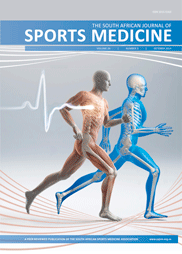Steps that count: Pedometer-measured physical activity, self-reported physical activity and current physical guidelines ‒ how do they relate?
Keywords:
Pedometer, Self-perceived, AerobicAbstract
Background. The association between self-perceived and actual physical activity, with particular reference to physical activity guidelines, may be an important factor in determining the extent of uptake of and compliance with physical activity.
Objectives. To examine the association between self-perceived and actual physical activity in relation to physical activity guidelines, with reference to volume, intensity and duration of steps/day, and to establish the level of agreement between pedometer-measured and selfreported ambulatory physical activity, in relation to current guidelines.
Methods. A convenience sample of adults (N=312; mean (standard deviation) age 37 (9) years), wore a pedometer (minimum 3 consecutive days) and completed a questionnaire that included information on physical activity patterns. Analyses of covariance, adjusted for age and gender, compared volume- and intensity-based steps according to meeting/not meeting guidelines (self-reported). The extent of agreement between self-reported and pedometer-measured physical activity was also determined.
Results. Average (SD) steps/day were 6 574 (3 541). Of a total of 312 participants’ self-reported data, those meeting guidelines (n=63) accumulated significantly more steps/day than those not meeting guidelines (8 753 (4 251) v. 6 022 (3 114) total steps/day and 1 772 (2 020) v. 421 (1 140) aerobic steps/day, respectively; p<0.0001). More than half of the group who self-reported meeting the guidelines did not meet guidelines as per pedometer data.
Conclusion. The use of pedometers as an alternative and/or adjunct to self-reported measures is an area for consideration. Steps/day recommendations that consider intensity-based steps may provide significant effects in improving fitness and health.
Downloads
Downloads
Additional Files
Published
How to Cite
Issue
Section
License
Copyright (c) 2014 South African Journal of Sports Medicine

This work is licensed under a Creative Commons Attribution 4.0 International License.
The South African Journal of Sports Medicine reserves copyright of the material published. The work is licensed under a Creative Commons Attribution 4.0 (CC BY 4.0) International License. Material submitted for publication in the South African Journal of Sports Medicine is accepted provided it has not been published elsewhere. The South African Journal of Sports Medicine does not hold itself responsible for statements made by the authors.




.png)